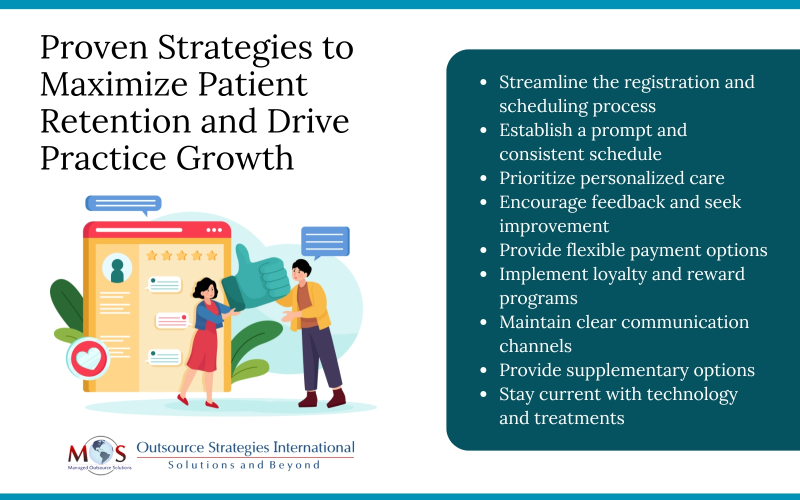In the ever-evolving landscape of the healthcare industry, implementing patient acquiring strategies may take the spotlight in 2025 in the efforts to enhance revenue growth. However, a notable fact is that the cost of acquiring new patients is 5-7 times more than retaining existing ones. This data underscores the importance of patient retention strategies in driving sustainable healthcare practice growth.
The foundation of a successful practice lies in not only attracting new patients, but also in building long-term relationships with current ones. Despite its significance, maintaining old customers is a complicated and intricate process which requires an effective patient retention strategy. It is not enough to just render quality care, as it is only a single aspect of the multifaceted approach of the entire patient experience ecosystem.
Before diving into effective strategies to encourage patients to return, it’s important to understand what patient retention truly means.
What Is Patient Retention?
Patient retention in medical practice management, also referred to as customer retention, is a metric that measures the percentage of patients who keep coming back to the same provider for long-term services. It is the ability of healthcare providers that ensures patients return for continued services, be it follow-up visits, preventive care, or any other healthcare offerings. A high retention rate indicates positive patient experience, high-quality care, and long-lasting success for healthcare practices.
Although physicians and other medical professionals plan, engage, and execute treatment plans for improved health outcomes, patients may still require ongoing care. Specialty fields such as cardiology and psychiatry provide a series of treatments and assistance for achieving successful results. While continuity of care is crucial, it is not always sufficient to maintain high retention rates. Patients may leave and discontinue services at your practice for a variety of reasons, such as:
- Poor communication and high costs
- Ineffective treatment and dissatisfaction with care
- Long wait times or scheduling conflicts
- Insurance coverage issues or high out-of-pocket costs
- The availability of better healthcare providers and increased competition
If these issues persist at your practice over a prolonged period, they can contribute to a high churn rate, which is the inverse of retention rate. Implementing effective retention initiatives is the key to not only unlocking better relationships with patients, but also reducing challenges. Healthcare organizations can outsource to healthcare billing services for streamlining their billing processes, increasing patient satisfaction, and ultimately, boosting revenue flow for practice success.
Why Is Patient Retention Important?
A high patient retention rate is crucial for the long-term success of healthcare organizations, going beyond just increasing cash flow. Regular patients provide numerous benefits, such as consistent revenue, increased referrals, and practice credibility.
- Cost-effective: Attracting new patients requires significant investment in strategies like digital marketing, billboard advertising, and sponsorship events. According to a Harvard Business Review, increasing retention by just 5% can boost profits by 25% to 95%. Retention strategies help cover the overhead costs of patient acquisition and contribute to better overall revenue.
- Enhanced authority: Today’s patients are more tech-savvy and research-driven, thoroughly evaluating healthcare providers before making decisions. By providing high-quality care and fostering strong patient relationships, practices can retain existing patients while building their credibility. Positive reviews, testimonials, and high ratings shared online enhance your practice’s reputation, attracting new patients and reinforcing your authority in the field.
- Revenue growth: Long-term patients are a key driver of revenue growth, as they consistently seek care from providers they trust. Satisfied patients are also more likely to recommend your practice to others, leading to increased referrals and an improved reputation. This steady stream of trust and referrals further boosts engagement and profitability.
Unlock the strategy to long-term patient loyalty and maximize your practice’s success with our expert medical billing services!
Best Patient Retention Strategies for Practice Growth
Developing efficient repeat business for your practice requires a comprehensive solution to build a strong patient base. It encompasses various patient experience aspects such as care quality, financial flexibility, and reward programs to enhance customer relationships. As each medical specialty has its own specific requirements, needs, and goals, crafting a tailored retention strategy is the ideal option for practices. However, there are basic strategies that healthcare entities still need to follow regardless of their specialty or objectives to promote growth.
Here are the top ten tips for building patient loyalty in 2025:
- Streamline the registration and scheduling process: Simplified access to patient registration and appointment scheduling is the first step to retain patients. Integrating automation for user-friendly processes with online booking, automatic appointment reminders, and registration portal, is crucial. Since your website serves as the first touch point for potential patients, ensuring seamless accessibility and flexibility to manage their own schedule leads to better patient intake.
- Establish a prompt and consistent schedule: Develop and establish a prompt and consistent schedule at your practice to improve productivity and reduce wait times. Modern patients value time, so minimizing wait times with a queue management system and timely reminders is essential to avoid frustrated customers. Additionally, implementing front desk best practices with trained staff, on-site parking, and late arrival policy system can streamline clinical interactions.
- Prioritize personalized care: Personalized care fosters deeper connections between patients and providers, as they value compassionate care. Take time to understand not only symptoms but also patient concerns to nurture a memorable and collaborative environment. A human-centered approach will not only improve patient satisfaction but also make patients feel valued, increasing their likelihood of returning.
- Encourage feedback and seek improvement: Like any other professional relationship, healthcare provider – patient relationship requires ongoing attention. Actively request and assess patient insights with feedback systems and surveys to improve communication, identify areas of improvement, and build trust. Promptly and professionally addressing every review strengthens patient loyalty by demonstrating that you are responsive and committed to providing the best possible experience. Adopting follow-up care best practices plays a key role in maintaining continuity of care and increasing patient satisfaction.
- Flexible payment options: With an increasing number of patients seeking flexible payment options, it is essential to provide payment systems that align with modern preferences. Offering online payment methods, installment plans, or transparent pricing options can reduce financial barriers for patients and improve reimbursement rates. Additionally, flexible payment plans will lead to optimized medical revenue cycle management, enhancing consistent cash flow for practices.
- Implement loyalty and reward programs: Rewarding loyal patients is an effective way to keep them engaged and encourage repeat visits. Consider offering referral bonuses, discounts on services, or rewards for patients who regularly attend their appointments or follow through with recommended treatments. Creating a patient loyalty program not only incentivizes return visits but also strengthens the emotional connection patients have with your practice.
- Maintain clear communication channels: Establish consistent, clear communication with patients via email, phone calls, or text reminders. Using digital tools for improving patient communication supports follow-up care best practices and ensures greater continuity of care across the patient journey. Providing patients with easy access to their medical records, test results, and appointment information via patient portal helps them stay engaged in their care and fosters trust. Promptly responding to inquiries also ensures that patients feel valued and supported.
- Provide supplementary options: Incorporating supplementary services such as telehealth and telemedicine allows patients to access care in a way that fits their specific needs. For patients with mobility issues, those in rural areas or individuals with tight schedules, virtual medicine options can enhance accessibility and convenience. Providing telehealth as part of your practice’s services shows a commitment to meeting patients where they are, improving satisfaction and retention rates.
- Stay current with technology and treatments: As medical advancements continue to shape healthcare, staying up to date with the latest technology and treatment options is crucial. Providing the latest and most effective treatments can enhance health outcomes, making your practice more appealing to both existing and potential patients. Additionally, implementing cutting-edge tools and diagnostic equipment can help demonstrate a commitment to delivering high-quality service.
- Focus on continuing education and preventative care: Educating patients about their health and offering preventative care services can help keep them engaged with your practice. Regular check-ins, educational resources, and promoting healthy habits can build long-term patient relationships and reduce the need for urgent visits, fostering consistent business.

Achieve Sustained Practice Success with Outsourcing Solutions
Practices outsourcing to a medical billing company can streamline their clinical operations and billing systems to increase overall efficiency and productivity. By adopting their strategies, practices can build lasting relationships with patients and foster sustainable growth. Tracking patient retention metrics is important to understand patient loyalty, identify factors contributing to patient satisfaction, and develop patient loyalty programs.




